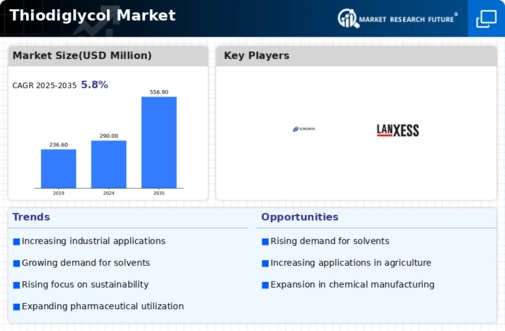Market Analysis
In-depth Analysis of Thiodiglycol Market Industry Landscape
The market dynamics of the Thiodiglycol (TDG) market are influenced by various factors that impact its supply, demand, and pricing. TDG, a key chemical compound used in industries such as chemical manufacturing, cosmetics, and textiles, experiences fluctuating dynamics driven by factors like raw material availability, regulatory policies, technological advancements, and market trends.
One significant aspect shaping the TDG market is its demand from diverse industries. For instance, in the chemical sector, TDG finds extensive use as a solvent and a precursor in the synthesis of various chemicals. Its role in manufacturing agents like mustard gas and in the production of sulfur-containing compounds further enhances its demand. Similarly, TDG's presence in cosmetics as a solvent and in textile industries for dyeing processes contributes to its market dynamics.
Supply-side factors also play a crucial role. The availability and cost of raw materials needed for TDG production, such as ethylene oxide and hydrogen sulfide, directly impact its supply chain. Any disruptions or fluctuations in these raw material markets can lead to price variations and supply constraints for TDG manufacturers.
Regulatory policies significantly influence the TDG market dynamics. Due to its use in chemical warfare agents, TDG is subject to stringent regulations, including restrictions on production, storage, and transportation. Compliance with safety standards and environmental regulations adds operational costs for manufacturers, impacting pricing strategies and market competitiveness.
Technological advancements drive innovation in TDG production processes, leading to improved efficiency, reduced costs, and enhanced product quality. Adoption of advanced manufacturing technologies, such as continuous flow processes and green chemistry principles, can positively influence the market dynamics by increasing production capacity and reducing environmental impact.
Market trends and consumer preferences also shape the TDG market dynamics. Growing awareness regarding environmental sustainability drives demand for eco-friendly alternatives and encourages manufacturers to invest in green technologies for TDG production. Additionally, shifting consumer preferences towards safer and non-toxic products in industries like cosmetics and personal care drive the demand for TDG-free formulations.
Global economic factors, including GDP growth, currency exchange rates, and trade policies, have a significant impact on the TDG market dynamics. Economic downturns can lead to reduced consumer spending and industrial activity, affecting the demand for TDG across various end-use industries.
Moreover, geopolitical tensions and trade disputes can disrupt the supply chain and market access for TDG manufacturers, leading to volatility in prices and market uncertainty. Strategic alliances, mergers, and acquisitions among key players in the TDG market also influence market dynamics by altering competitive landscapes and market shares.





Leave a Comment